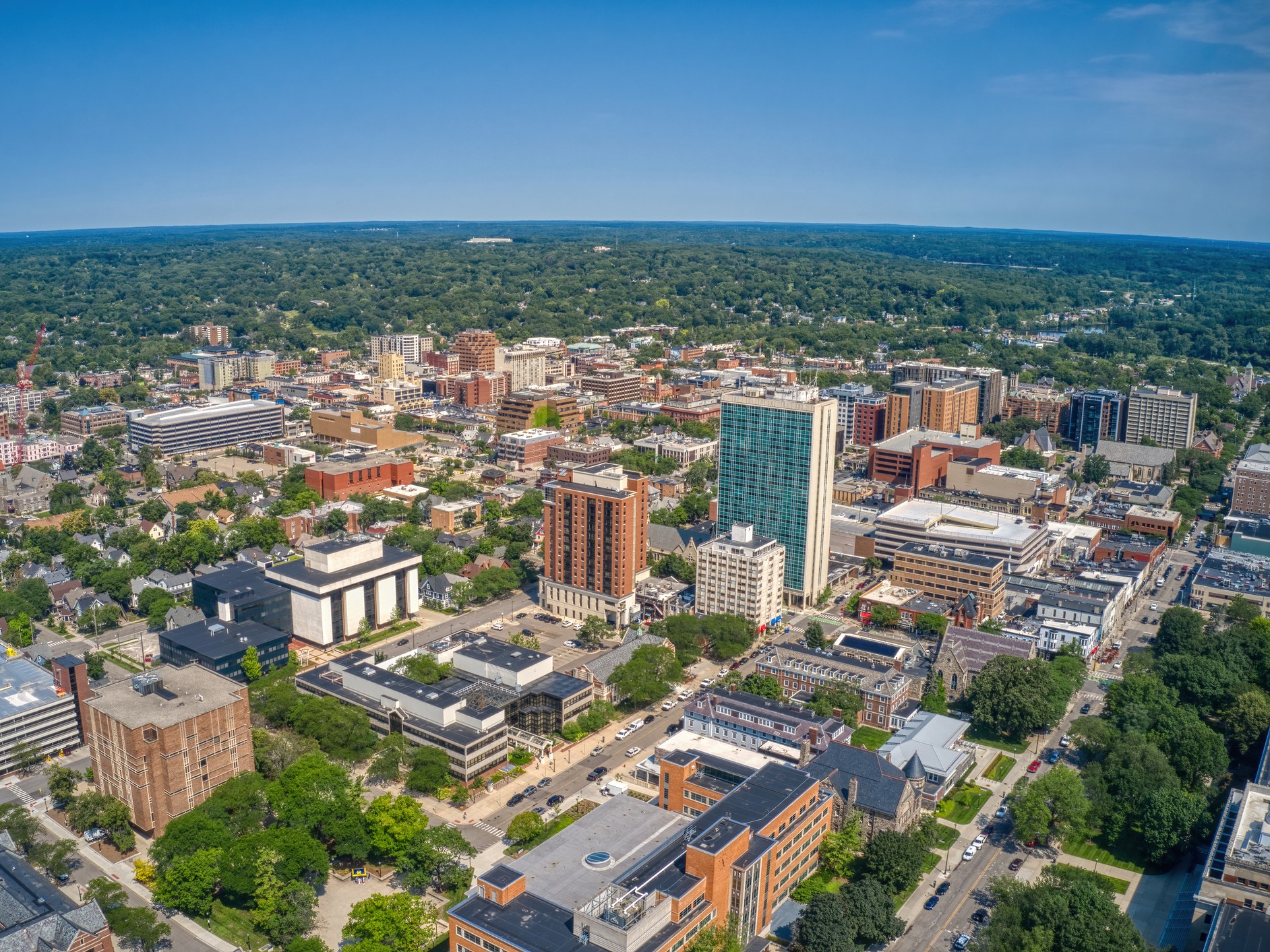University of Michigan’s RSQE releases 2025–2027 economic outlook
Photo: Aerial view of downtown Ann Arbor. Source: Wirestock
Washtenaw County’s economic engine is expected to downshift over the next three years, according to the April 2025 forecast by the University of Michigan’s Research Seminar in Quantitative Economics (RSQE), a modeling and forecasting unit active since 1952. While job growth will continue, it is projected to slow considerably, and the county’s once-substantial wage advantage is now lagging behind the national average.
The RSQE report warns that “the path of federal economic policy poses significant challenges for the county economy in the coming years.” These include heightened tariffs and expected cuts to federal research funding, both of which have direct implications for Washtenaw’s large education and research sectors.
Employment: Growth Slows to a Crawl
Washtenaw County’s payroll employment growth is forecast to decelerate sharply, from 2.0% in 2023 and 0.6% in 2024 to just 0.2% in 2025. Growth is expected to rise slightly to 0.4% in 2026 and 0.6% in 2027, “well below the pre-pandemic average of 1.9 percent annually from 2010–2019.” By the end of 2027, total employment in the county will be only 0.6% above its pre-pandemic level, compared to 2.8% for the state of Michigan.
The report projects the strongest gains in private health and social services, which are expected to add 1,400 jobs. In contrast, “we now expect a loss of 200 jobs amid these unforeseen changes” in state government employment due to reduced research funding. Manufacturing, retail trade, and administrative support services are forecast to continue their long-term decline.
Rising Unemployment, Growing Labor Force
The unemployment rate in Washtenaw County rose from 3.5% in May 2024 to 4.7% in January 2025. RSQE projects the local jobless rate will stabilize at 4.4% through 2027— “about one-half of a percentage point below our forecast for the state.”
Despite the softening labor market, more residents are seeking work. “By 2027, we expect the labor force to exceed its 2019 level by 6.7 percent.”
Wages: Washtenaw Falls Behind
After three years of declines, real wage growth in Washtenaw County turned positive in 2024, rising 1.9%. Modest increases of 0.5% annually are forecast through 2027 (p. 3). Still, the county’s wage advantage is slipping. “Washtenaw’s average real wage is projected to exceed its 2019 level by only 2.7 percent, compared to 7.4 percent for Michigan.”
Once nearly $10,000 above the national average, “the county’s average real wage… has since fallen $1,600 below as of 2023.” The report identifies a weakening private sector as the main culprit, particularly in the motor vehicle parts and private higher-education attainment industries.
Uncertainty at the National Level
Broader economic factors are clouding the outlook. The Monthly Economic Policy Uncertainty Index for the U.S. reached 234 in February, “its third-highest level on record.” While RSQE assumes tariffs and research funding reductions won’t worsen drastically, it cautions: “We have tentatively estimated that reductions in federal research funding will reduce employment in Washtenaw County’s state government sector… by a bit more than 2,000 jobs over the next two years.”
Industry Breakdown: Mixed Performance
The RSQE provides a detailed forecast of jobs in Washtenaw County by industry. Key takeaways from 2025 to 2027 include:
- Private health and social services: +1,400 jobs
- Arts, entertainment, and recreation: strong growth, reaching 15.2% above 2019 levels
- Motor vehicle manufacturing: projected to lose 180 jobs
- Retail trade: forecast to decline by 40 jobs annually
- Administrative and support services: expected to lose 420 jobs, ending 27% below 2019 levels
Inflation: Tariffs Pose Risk
Local inflation, as measured by the Detroit Consumer Price Index, is expected to hold steady at around 2.5–2.6% annually through 2027. However, RSQE warns that “the evolving tariffs suggest there is much upside risk to those projections.”
Conclusion
While Washtenaw County retains strengths in education, healthcare, and a highly educated workforce, the forecast reflects “a notable downshift from last year’s robust outlook.” Policymakers and institutions may need to brace for a period of slower growth and intensified economic uncertainty.
Find the complete Washtenaw County Forecast at https://lsa.umich.edu/econ/rsqe.html





 8123 Main St Suite 200 Dexter, MI 48130
8123 Main St Suite 200 Dexter, MI 48130


